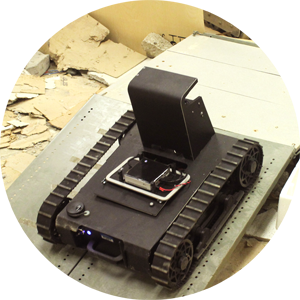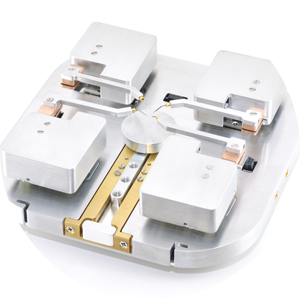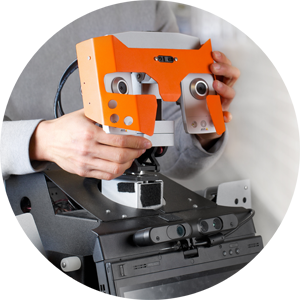“After the computer and the smartphone, robotics is the next big technology that will change our lives,” Professor Goldie Nejat (MIE) told a hushed crowd of 12 journalists assembled in her lab. “We focus on developing the intelligence and interactive capabilities of robots.”
The group visited three labs in the Department of Mechanical & Industrial Engineering on Monday, March 1 to learn about the University of Toronto’s expertise in robotics and automation, part of a four-day tour organized by Ontario’s Ministry of Economic Development, Employment and Infrastructure.
Nejat is the Canada Research Chair in Robots for Society, as well as director of the Institute for Robotics and Mechatronics (IRM), which unites multidisciplinary researchers and industry partners working in the fields of robotics and automation. One of her research areas focuses on addressing our changing demographics and concentrates on developing social robots that can provide needed assistance with activities of daily living for the elderly in order to promote aging-in-place and improve their quality of life.
“The whole idea of this lab is to help and support people with daily activities that get harder as we get older,” said Nejat. A reporter asked her how long we have to wait before humanoid robots are working inside our homes. “We are now at the point where we can make that prediction,” she said. “More personal robots are about five to ten years from deployment — it’s very close.”
From robots that can look you in the eye, to robots you can barely see: Professor Yu Sun (MIE, ECE, IBBME), Canada Research Chair in Micro and Nano Engineering Systems, is developing a fleet of minuscule robots to perform tasks from performing surgery on a cell and inside a cell, to improving high-throughput drug testing for personalized medicine.
One of Sun’s projects involves using robots to select the best individual sperm for fertilization, tapping it with a tiny needle to immobilize it, picking it up, and injecting it into an egg cell to fertilize it.
“This is medical robotics at the cellular level, in many ways like the da Vinci surgical robot at the tissue level,” said Sun, referring to the sophisticated system of robotic arms surgeons use to perform complex surgeries less invasively. “Robots can perform these precise manoeuvres more consistently than humans can, and assisting surgeons with robotic systems can greatly improve the outcome for the patient.”
Meet a few of the IRM robots that may someday help you at home or in the hospital:
 Tangy
Tangy
Tangy is a socially assistive robot designed to facilitate recreational activities and promote social interaction among people with degenerative cognitive conditions, such as dementia. Tangy tells jokes and leads individuals or groups in games of Bingo, which exercises memory, recognition and fine motor skills. “Unfortunately, a lot of nursing homes are understaffed and recreational activities are sometimes where those cuts are felt,” said Nejat. “We’re using the robot as a rehabilitation or cognitive intervention tool to see if such robots are effective in prolonging the onset or progression of cognitive impairments while also encouraging social interactions.”
 Search & Rescue Assistant Robots
Search & Rescue Assistant Robots
After a natural disaster, the clock is ticking: the first 72 hours following a devastating earthquake or tsunami are the most critical for finding and rescuing survivors. Search and rescue robots can be used to explore and map collapsed buildings in three dimensions while looking for victims, in order to assist rescue workers in such stressful and time-critical situations. Robots can be sent into unknown environments where it maybe just too dangerous for rescue workers. Robots tag the location of survivors on a map they generate and rescue workers can use these maps to isolate their search efforts to increase the number of victims found.
 LifeForce: the Nano Robot
LifeForce: the Nano Robot
Part of understanding the causes of genetic disorders is finding out why certain genes prefer to reside in specific locations inside the cell nucleus. This ultra-precision nano robot is capable of extracting a single chromatin from within a cell nucleus without disturbing the rest of the nuclear structures, to 3D map preferred locations of genes. “It’s like a nanometer-sized shovel,” says Sun. “It can robotically shovel target genetic materials out of a single cell nucleus, to understand gene location variations under normal and disease conditions.”




